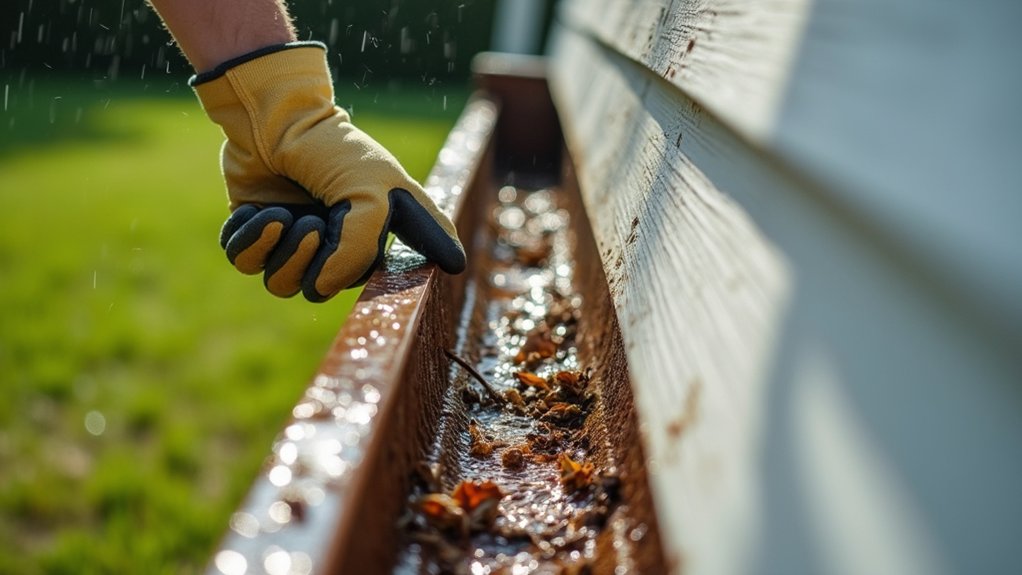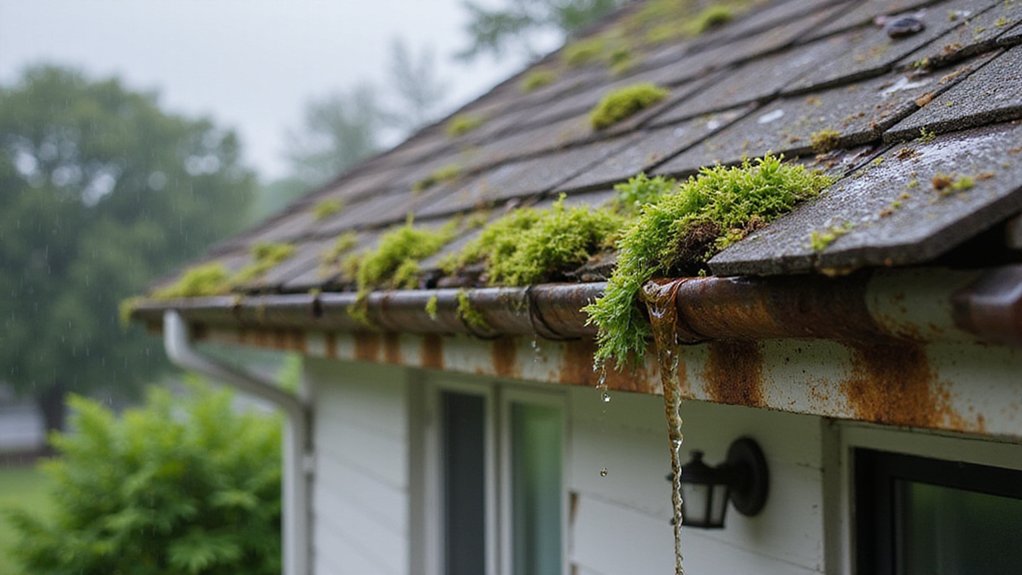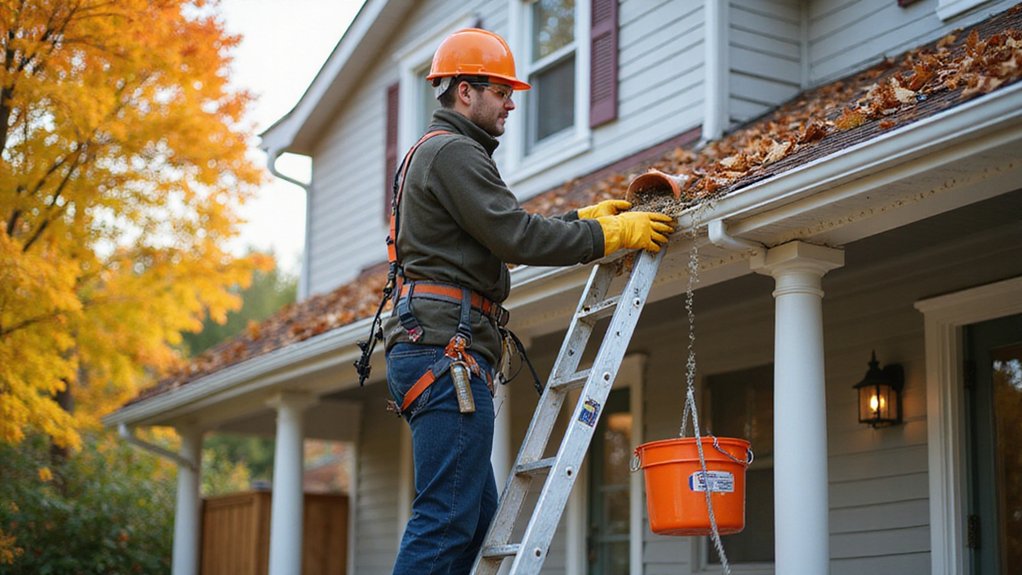Ensure your gutters are functioning properly to prevent water damage to your home. Start by obtaining a sturdy ladder and some gloves to inspect for debris. Clearing out leaves and dirt is your initial step to proper drainage. But there’s more to check—slope, alignment, and connections all play a part. Adhere to this process to reveal potential issues before they escalate.
Gathering the Necessary Tools
Before you begin inspecting your gutters for proper drainage, make sure you’ve got the right tools on hand. Grab a sturdy ladder, gloves, a small trowel, and a bucket to collect debris. You’ll also need a hose for testing flow later. These essentials guarantee you’re ready for checking gutter components thoroughly and safely.
As part of our home maintenance crew, equip yourself for evaluating gutter materials too. A flashlight helps spot wear or rust on metal sections. Keep a notepad handy to jot down issues. With these tools, you’re set to tackle gutter care like a pro.
Inspecting for Visible Blockages
While you’re geared up with your tools, start by scanning your gutters for visible blockages that can interfere with drainage. Look closely for leaves, twigs, or dirt clogging the channels. When inspecting for debris buildup, use a gloved hand or a small scoop to remove obstructions, ensuring water flows freely.
Next, focus on examining gutter integrity—check for cracks, holes, or rust that could worsen blockages. You’re part of a community that values well-maintained homes, so tackle these issues promptly. Clearing blockages now prevents costly water damage and structural issues later, keeping your gutter system reliable and effective.
Checking the Slope and Alignment
Anyone, take a moment to assess your gutters for proper slope and alignment to ascertain water drains efficiently.
As part of our shared effort to maintain homes, start by evaluating gutter slope. Use a level to check if the gutter tilts slightly toward downspouts, ideally dropping ¼ inch every 10 feet.
Next, focus on verifying gutter alignment. Confirm sections connect seamlessly without sags or mismatches that could trap water. If you spot issues, adjust brackets or tighten fasteners.
We’re in this together—properly aligned gutters protect our homes from water damage and keep everything functioning smoothly.
Testing Water Flow With a Hose
Having investigated previous issues, now tackle
Examining Downspout Connections
Examine your downspout connections to ascertain they’re secure and functioning properly. As part of our shared commitment to maintaining our homes, take a close look at each connection point where downspouts meet gutters or extensions.
When assessing downspout condition, check for loose screws, rusty brackets, or visible cracks that could lead to leaks. Tighten or replace any faulty hardware to verify stability. While appraising downspout placement, confirm they direct water away from your foundation, preventing potential damage.
Assessing Nearby Landscaping Impact
How does the landscaping near your home affect your gutter drainage? You’re part of a community that values a well-maintained property, and understanding this impact is key. Nearby plants and terrain can disrupt water flow if not managed properly.
Consider these critical factors:
- Analyzing terrain elevation – Check if slopes direct water toward or away from your gutters; uneven ground can cause pooling.
- Monitoring foliage growth – Trim overhanging branches or shrubs that drop debris into gutters, blocking flow.
- Soil condition – Maintain soil near downspouts to prevent erosion, as it affects drainage efficiency.
Scheduling Regular Maintenance Checks
Three key times a year—spring, summer, and fall—mark the ideal schedule for inspecting your gutters to ascertain proper drainage. As part of our shared commitment to home care, set these seasonal checks on your calendar to stay ahead of problems.
During each inspection, focus on identifying potential issues like clogs, leaks, or sagging sections that could interrupt water flow. For thoroughness, consider scheduling professional inspections annually, especially before heavy rain seasons. Their proficiency guarantees hidden flaws don’t go unnoticed.
Join our community of proactive homeowners by maintaining your gutters diligently, safeguarding your home year-round.
Frequently Asked Questions
Why Do Gutters Overflow Even After Cleaning?
Wonder why your gutters overflow despite cleaning? Check for an insufficient gutter slope; water won’t drain right. Inspect clogged downspout outlets too. Fix these, and you’ll keep your system flowing with our community’s support!
Can Heavy Rain Damage Gutter Systems?
You’ve gotta know, heavy rain can indeed damage gutter systems. It causes heavy rain erosion on weak spots and heightens water backup risks. Inspect regularly, and join us in maintaining sturdy, reliable gutters.
How Often Should Gutters Be Replaced?
Wondering how often you should tackle gutter replacement? Typically, gutter replacement lifespan is 20-30 years, depending on material. Stick to a strict gutter maintenance schedule, and you’ll extend their life with us together.
Are Gutter Guards Worth the Investment?
Wondering if gutter guards are worth the investment? You’ll find that effective gutter guard installation reduces maintenance, while long-term gutter guard durability saves money. Join the savvy homeowners protecting their homes with smart solutions.
What Causes Rust in Metal Gutters?
Wondering what causes rust in metal gutters? It’s mainly metal corrosion from moisture and oxygen exposure. Galvanic action happens when dissimilar metals connect, speeding up decay. Inspect regularly, and you’re part of our savvy crew!


